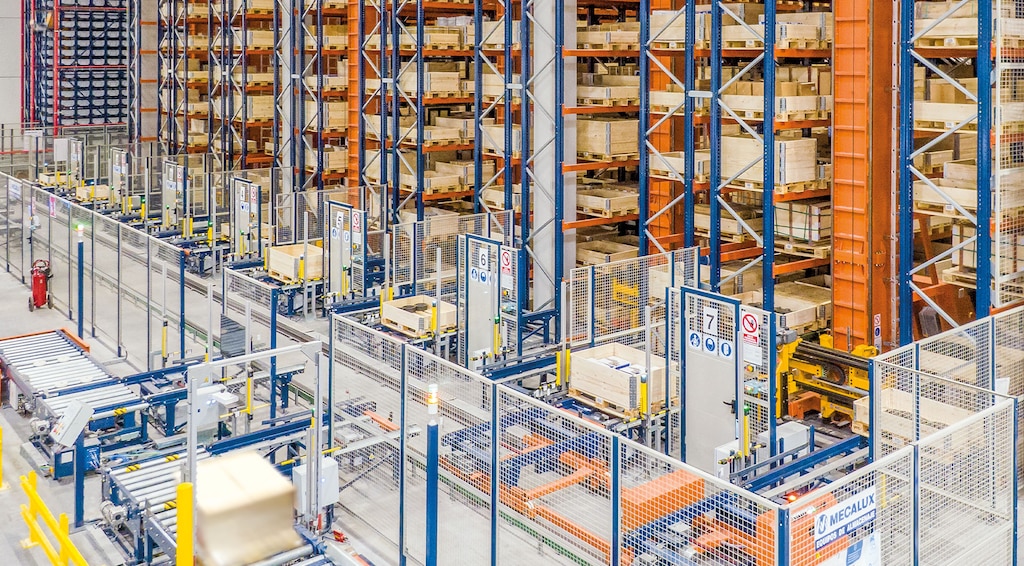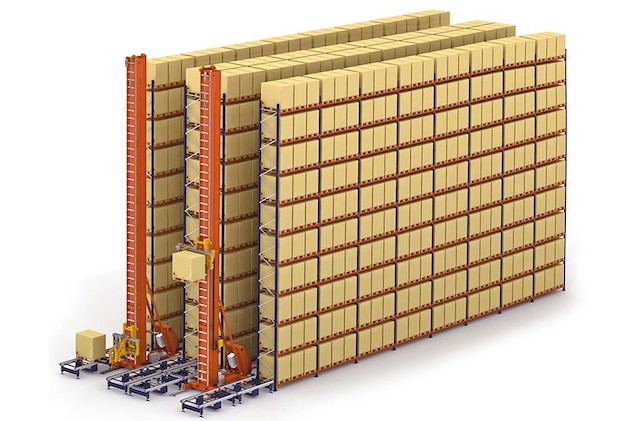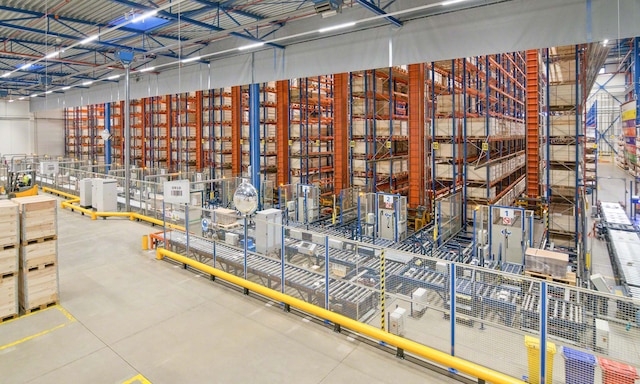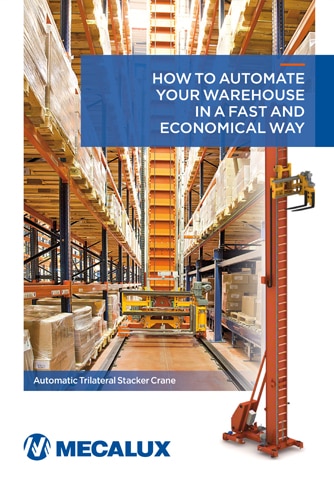
Automated Trilateral Stacker Cranes
System designed to automate pallet storage quickly and simply. The perfect solution to replace trilateral forklifts.
The product
Ideal solution for easily automating a new or existing warehouse
Trilateral stacker cranes are the simplest, most cost-effective option for automating pallet storage and retrieval in warehouse racking. Unlike other stacker cranes, they can replace trilateral forklifts in an existing conventional storage system without requiring modifications to the warehouse’s design or racking.
These stacker cranes are equipped with a trilateral extraction system — trilateral meaning the forks can rotate 180° to access pallets from the front, left and right. The machines work autonomously, handling pallets in conventional racking up to 15 m high. Their implementation optimises warehouse performance, eliminates errors and improves safety.

Advantages of trilateral stacker cranes
- Great adaptability and easy implementation: trilateral stacker cranes are suitable for any facility with conventional pallet racking served by trilateral forklifts.
- Increased productivity: these machines operate 24/7 with combined cycle functionality for greater efficiency.
- Total automation: when integrated with a pallet conveyor system at the front of the racking, automatic stacking cranes enable completely automated load handling.
- Maximum space utilisation: unlike other stacker cranes, they operate from floor level and require no upper guide base, allowing full use of warehouse height.
- Error reduction: automated pallet storage and retrieval eliminate mistakes due to manual handling.
- Enhanced safety: replacing forklifts with stacker cranes significantly improves occupational safety.
- Comprehensive solution: Mecalux designs, manufactures, installs and commissions the stacker cranes in addition to the conveyor, warehouse management and warehouse control systems.

We’ve maximised both process efficiency and workplace safety in the warehouse
Applications of trilateral stacker cranes
Automated storage for warehouses up to 15 m high
Trilateral stacker cranes are the storage solution designed to quickly and cost-effectively automate a wide variety of conventional facilities.
How the automated trilateral stacker crane works
Solution that fully automates the storage and retrieval of palletised loads
Trilateral stacker cranes are designed to perform three different movements: longitudinal (to move along the aisle), vertical (to lift and lower goods) and depth, where the trilateral forks are inserted into the racking to deposit and remove pallets.
Testimonials
Case studies
See more case studiesAutomatic trilateral stacker crane components
Automated trilateral stacker cranes are essentially made up of three main parts: a mast, an extraction system and a lower guide base. They are also equipped with an electrical system and motors. Unlike other stacker cranes, they have no upper guide base, simplifying installation in existing warehouses.
The mechanical components form the basic structure of the stacker crane. The mast enables vertical lifting, the lower guide base and rails ensure horizontal travel, and the forks handle the insertion and retrieval of pallets.
The stacker crane receives power from an on-board electrical cabinet. It is equipped with three motors, each corresponding to the machine’s movement: one for travel along the aisle, another for vertical lift and a third for pallet storage/retrieval.
FAQs
The automatic trilateral stacker crane is a storage solution designed to easily automate conventional racking up to 15 m high, typically operated by trilateral forklifts. This stacker crane’s fully automated operation streamlines pallet storage and retrieval, minimises errors and boosts warehouse productivity.
Like trilateral forklifts, trilateral stacker cranes are designed to operate in racking systems with very narrow aisles. The main difference lies in their fully autonomous operation: stacker cranes can completely automate pallet storage and retrieval. In other words, trilateral stacker cranes are an evolution of trilateral forklifts — a simple and cost-effective replacement that makes use of the same aisle width and existing racking.
The first key difference is the type of extraction system. Trilateral stacker cranes are equipped with trilateral forks mounted on a rotating head. This allows them to move in three directions to access pallets: left, right and front. In contrast, other stacker cranes typically use an extraction system comprising telescopic forks that operate in just two directions — left and right.
Another distinguishing feature is that trilateral stacker cranes do not require an upper guide rail or upper guide base. They can also store and retrieve pallets directly at floor level. Together, these characteristics make it possible to optimise available vertical space more effectively than other types of stacker cranes. However, trilateral stacker cranes are limited to a maximum height of 15 m. For taller automated storage and retrieval systems (AS/RSs), Mecalux offers other pallet stacker crane models that can reach heights of up to 45 m.
Trilateral stacker cranes are compatible with conventional single-deep pallet racking up to 15 m high.
Not at all. This is the simplest type of stacker crane, specifically designed to automate conventional warehouses previously operated with trilateral forklifts. In fact, these stacking cranes can be implemented without altering the existing racking layout or aisle width.
No. Unlike trilateral forklifts, trilateral stacker cranes do not require a completely level floor. Any unevenness can easily be corrected by installing the lower rails along which the stacker crane travels.
Automated trilateral stacker cranes can handle pallets weighing up to 1,200 kg.
Trilateral stacker cranes are designed to work in very narrow aisles. The minimum clearance between unit loads stored on opposite sides of the aisle ranges from 1.76 to 1.86 m.
The automated trilateral stacker crane can reach a maximum travel speed of 100 m/min.
Trilateral stacker cranes achieve a maximum lift speed of 30 m/min for 1,200 kg pallets and 38 m/min for 1,000 kg pallets.
Trilateral stacker cranes can operate in temperatures ranging from 0 °C to 40 °C with up to 70% humidity.
Yes. The automated trilateral stacker crane operates with two types of software. A WMS (warehouse management system) assigns locations to each unit load, while a WCS (warehouse control system) sends movement instructions to the stacker crane. Mecalux can supply both software solutions.
Ask an expert














































